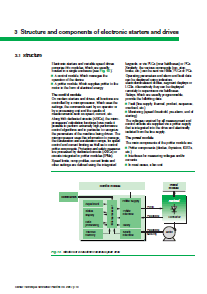Starting asynchronous motors
The most common way of starting asynchronous motors is directly on the line supply.
This technique is often suitable for a wide variety of machines. However, it sometimes brings with it restrictions that can be inconvenient for some applications, and even incompatible with the functions required from the machine:
- The inrush current on start-up can interfere with the operation of other devices connected on the same line supply
- Mechanical shocks during starting that cannot be tolerated by the machine or may endanger the comfort and safety of users
- Acceleration and deceleration cannot be controlled
- Speed cannot be controlled
Starters and variable speed drives are able to counter these problems. Electronic technology has made them more flexible and has extended their field of application. However, it is still important to make the right choice. The purpose of this “Cahier Technique” is to provide more extensive information about these devices in order to make it easier to define them when designing equipment or when improving or even replacing a motor switchgear assembly for control and protection.
Brief history
Originally, rheostatic starters, mechanical drives and rotating sets (Ward Leonard in particular) were used for starting electric motors and controlling their speed. Later, electronic starters and drives came to the fore as a modern, costeffective, reliable and maintenance-free solution for industrial applications. An electronic drive or starter is an energy converter, which modulates the electrical energy supplied to the motor.
Electronic starters are used solely for asynchronous motors. They are a type of voltage controller. Variable speed drives ensure gradual acceleration and deceleration and enable speed to be matched precisely to operating conditions. Controlled rectifier type variable speed drives are used to supply power to DC motors and frequency inverters are used for AC motors.
Historically, drives for DC motors appeared first. Reliable and cost-effective frequency inverters appeared as a result of advances in power electronics and microelectronics. Modern frequency inverters can be used to supply power to standard asynchronous motors with performance levels similar to those of the best DC variable speed drives. Some manufacturers even offer asynchronous motors with electronic variable speed drives housed in a custom-made terminal box. This solution is designed for reduced power assemblies (only a few kW).
Recent developments in variable speed drives and information about current manufacturer trends appear at the end of this “Cahier Technique”. These developments are significantly expanding the drives on offer and their options.
AUTHOR: Schneider Electric expert | Daniel CLENET
| Title: | Electronic starters and variable speed drives |
| Format: | |
| Size: | 0.35MB |
| Pages: | 30 |
| Download: | Right here | Video Courses | Membership | Download Updates |


